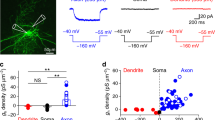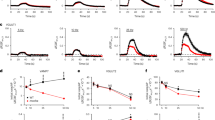Abstract
The excitability of CNS presynaptic terminals after a tetanic burst of action potentials is important for synaptic plasticity. The mechanisms that regulate excitability, however, are not well understood. Using direct recordings from the rat calyx of Held terminal, we found that a fast Na+/K+-ATPase (NKA)-mediated post-tetanic hyperpolarization (PTH) controls the probability and precision of subsequent firing. Notably, increasing the concentration of internal Ca2+ buffers or decreasing Ca2+ influx led to larger PTH amplitudes, indicating that an increase in [Ca2+]i regulates PTH via inhibition of NKAs. The characterization for the first time of a presynaptic NKA pump current, combined with immunofluorescence staining, identified the α3-NKA isoform on calyx terminals. Accordingly, the increased ability of the calyx to faithfully fire during a high-frequency train as it matures is paralleled by a larger expression of α3-NKA during development. We propose that this newly discovered Ca2+ dependence of PTH is important in the post-burst excitability of nerve terminals.
This is a preview of subscription content, access via your institution
Access options
Subscribe to this journal
Receive 12 print issues and online access
$209.00 per year
only $17.42 per issue
Buy this article
- Purchase on Springer Link
- Instant access to full article PDF
Prices may be subject to local taxes which are calculated during checkout








Similar content being viewed by others
References
Debanne, D. Information processing in the axon. Nat. Rev. Neurosci. 5, 304–316 (2004).
Ames, A. CNS energy metabolism as related to function. Brain Res. Brain Res. Rev. 34, 42–68 (2000).
Clarke, D.D. & Sokoloff, L. Circulation and energy metabolism of the brain. in Basic Neurochemistry (eds. Siegel, G.J., Agranoff, B.W., Albers, R.W. & Molinoff, P.B.) 645–680 (Raven, New York, 1994).
Carr, C.E., Soares, D., Parameshwaran, S. & Perney, T. Evolution and development of time coding systems. Curr. Opin. Neurobiol. 11, 727–733 (2001).
Wetzel, R.K., Arystarkhova, E. & Sweadner, K.J. Cellular and subcellular specification of Na,K-ATPase α and β isoforms in the postnatal development of mouse retina. J. Neurosci. 19, 9878–9889 (1999).
Schneider, J.W. et al. Tissue specificity, localization in brain, and cell-free translation of mRNA encoding the α3 isoform of Na+,K+-ATPase. Proc. Natl. Acad. Sci. USA 85, 284–288 (1988).
De Fusco, M. et al. Haploinsufficiency of ATP1A2 encoding the Na+/K+ pump α2 subunit associated with familial hemiplegic migraine type 2. Nat. Genet. 33, 192–196 (2003).
de Carvalho Aguiar, P. et al. Mutations in the Na+/K+ -ATPase α3 gene ATP1A3 are associated with rapid-onset dystonia parkinsonism. Neuron 43, 169–175 (2004).
Rang, H.P. & Ritchie, J.M. On the electrogenic sodium pump in mammalian non-myelinated nerve fibres and its activation by various external cations. J. Physiol. (Lond.) 196, 183–221 (1968).
Wojtowicz, J.M. & Atwood, H.L. Correlation of presynaptic and postsynaptic events during establishment of long-term facilitation at crayfish neuromuscular junction. J. Neurophysiol. 54, 220–230 (1985).
Morita, K., David, G., Barrett, J.N. & Barrett, E.F. Posttetanic hyperpolarization produced by electrogenic Na+-K+ pump in lizard axon impaled near their motor terminals. J. Neurophysiol. 70, 1874–1884 (1993).
Parker, D., Hill, R. & Grillner, S. Electrogenic pump and a Ca2+-dependent K+ conductance contribute to a posttetanic hyperpolarization in lamprey sensory neurons. J. Neurophysiol. 76, 540–553 (1996).
Manookin, M.B. & Demb, J.B. Presynaptic mechanism for slow contrast adaptation in mammalian retinal ganglion cells. Neuron 50, 453–464 (2006).
Soleng, A.F., Chiu, K. & Raastad, M. Unmyelinated axons in the rat hippocampus hyperpolarize and activate an H current when spike frequency exceeds 1 Hz. J. Physiol. (Lond.) 552, 459–470 (2003).
Wu, S.H. & Kelly, J.B. Response of neurons in the lateral superior olive and medial nucleus of the trapezoid body to repetitive stimulation: intracellular and extracellular recordings from mouse brain slice. Hear. Res. 68, 189–201 (1993).
Taschenberger, H. & von Gersdorff, H. Fine-tuning an auditory synapse for speed and fidelity: developmental changes in presynaptic waveform, EPSC kinetics, and synaptic plasticity. J. Neurosci. 20, 9162–9173 (2000).
Golding, N.L., Robertson, D. & Oertel, D. Recordings from slices indicate that octopus cells of the cochlear nucleus detect coincident firing of auditory nerve fibers with temporal precision. J. Neurosci. 15, 3138–3153 (1995).
Oertel, D. The role of timing in the brainstem auditory nuclei of vertebrates. Annu. Rev. Physiol. 61, 497–519 (1999).
Smith, P.H., Joris, P.X., Carney, L.H. & Yin, T.C. Projections of physiologically characterized globular bushy cell axons from the cochlear nucleus of the cat. J. Comp. Neurol. 304, 387–407 (1991).
Spirou, G.A., Brownell, W.E. & Zidanic, M. Recording from the cat trapezoid body and HRP labeling of globular bushy cell axons. J. Neurophysiol. 63, 1169–1190 (1990).
Sommer, I., Lingenhohl, K. & Friauf, E. Principal cells of the rat medial nucleus of the trapezoid body: an intracellular in vivo study of their physiology and morphology. Exp. Brain Res. 95, 223–239 (1993).
Kadner, A., Kulesza, R.J., Jr & Berrebi, A.S. Neurons in the medial nucleus of the trapezoid body and superior paraolivary nucleus of the rat may play a role in sound duration coding. J. Neurophysiol. 95, 1499–1508 (2006).
Clapham, D.E. Not so funny anymore: pacing channels are cloned. Neuron 21, 5–7 (1998).
Leão, R.N., Svahn, K., Berntson, A. & Walmsley, B. Hyperpolarization-activated (Ih) currents in auditory brainstem neurons of normal and congenitally deaf mice. Eur. J. Neurosci. 22, 147–157 (2005).
Cuttle, M.F., Rusznak, Z., Wong, A.Y., Owens, S. & Forsythe, I.D. Modulation of a presynaptic hyperpolarization-activated cationic current Ih at an excitatory synaptic terminal in the rat auditory brainstem. J. Physiol. (Lond.) 534, 733–744 (2001).
Abel, H.J., Lee, J.C.F., Callaway, J.C. & Foehring, R.C. Relationship between intracellular calcium and afterhyperpolarization in neocortical pyramidal neurons. J. Neurophysiol. 91, 324–335 (2004).
Ishikawa, T. et al. Distinct roles of Kv1 and Kv3 potassium channels at the calyx of Held presynaptic terminal. J. Neurosci. 23, 10445–10453 (2003).
Lohmann, C. & Friauf, E. Distribution of the calcium-binding proteins parvalbumin and calretinin in the auditory brainstem of adult and developing rats. J. Comp. Neurol. 367, 90–109 (1996).
Felmy, F. & Schneggenburger, R. Developmental expression of the Ca2+-binding proteins calretinin and parvalbumin at the calyx of Held of rats and mice. Eur. J. Neurosci. 20, 1473–1482 (2004).
Kim, M.H., Korogod, N., Schneggenburger, R., Ho, W.K. & Lee, S.H. Interplay between Na+/Ca2+ exchangers and mitochondria in Ca2+ clearance at the calyx of Held. J. Neurosci. 25, 6057–6065 (2005).
Zhong, N., Beaumont, V. & Zucker, R.S. Roles for mitochondrial and reverse mode Na+/Ca2+ exchange and the plasmalemma Ca2+ ATPase in post-tetanic potentiation at crayfish neuromuscular junctions. J. Neurosci. 21, 9598–9607 (2001).
Iwamoto, T. Forefront of Na+/Ca2+ exchanger studies: molecular pharmacology of Na+/Ca2+ exchange inhibitors. J. Pharmacol. Sci. 96, 27–32 (2004).
Hamada, K. et al. Properties of the Na+/K+ pump current in small neurons from adult rat dorsal root ganglia. Br. J. Pharmacol. 138, 1517–1527 (2003).
Horisberger, J.D. & Kharoubi-Hess, S. Functional differences between alpha subunit isoforms of the rat Na/K-ATPase expressed in Xenopus oocytes. J. Physiol. (Lond.) 539, 669–680 (2002).
Crambert, G.D. et al. Transport and pharmacological properties of nine different human Na/K-ATPase isozymes. J. Biol. Chem. 275, 1976–1986 (2000).
Habets, R.L. & Borst, J.G.G. Post-tetanic potentiation in the rat calyx of Held synapse. J. Physiol. (Lond.) 564, 173–187 (2005).
Borst, J.G.G. & Sakmann, B. Effect of changes in action potential shape on calcium currents and transmitter release in a calyx-type synapse of the rat auditory brainstem. Phil. Trans. R. Soc. Lond. B 354, 347–355 (1999).
Forsythe, I.D., Tsujimoto, T., Barnes-Davies, M., Cuttle, M.F. & Takahashi, T. Inactivation of presynaptic calcium current contributes to synaptic depression at a fast central synapse. Neuron 20, 797–807 (1998).
Wang, L.Y. & Kaczmarek, L.K. High-frequency firing helps replenish the readily releasable pool of synaptic vesicles. Nature 394, 384–388 (1998).
Forsythe, I.D. Direct patch recording from identified presynaptic terminals mediating glutamatergic EPSCs in the rat CNS, in vitro. J. Physiol. (Lond.) 479, 381–387 (1994).
Blanco, G. & Mercer, R.W. Isozymes of the Na-K-ATPase: heterogeneity in structure, diversity in function. Am. J. Physiol. 275, 633–650 (1998).
Senatorov, V.V. & Hu, B. Differential Na+/K+-ATPase activity in rat lemniscal and non-lemniscal auditory thalami. J. Physiol. (Lond.) 502, 387–395 (1997).
Dobretsov, M., Hastings, S.L. & Stimers, J.R. Functional Na+/K+ pump in rat dorsal root ganglia neurons. Neuroscience 93, 723–729 (1999).
Bhattacharjee, A. & Kaczmarek, L.K. For K+ channels, Na+ is the new Ca2+. Trends Neurosci. 28, 422–428 (2005).
Ishii, T. & Takeyasu, K. The C-terminal 165 amino acids of the plasma membrane Ca2+-ATPase confer Ca2+/calmodulin sensitivity on the Na+/K+-ATPase alpha-subunit. EMBO J. 14, 58–67 (1995).
Borst, J.G., Helmchen, F. & Sakmann, B. Pre- and postsynaptic whole-cell recordings in the medial nucleus of the trapezoid body of the rat. J. Physiol. (Lond.) 89, 825–840 (1995).
Korogod, N., Lou, X. & Schneggenburger, R. Presynaptic Ca2+ requirements and developmental regulation of posttetanic potentiation at the calyx of Held. J. Neurosci. 25, 5127–5137 (2005).
Leão, R.M. et al. Presynaptic Na+ channels: locus, development, and recovery from inactivation at a high-fidelity synapse. J. Neurosci. 25, 3724–3738 (2005).
Delaney, K.R. & Tank, D.W. A quantitative measurement of the dependence of short-term synaptic enhancement on presynaptic residual calcium. J. Neurosci. 14, 5885–5902 (1994).
Verdru, P., De Greef, C., Mertens, L., Carmeliet, E. & Callewaert, G. Na+-Ca2+ exchange in rat dorsal root ganglion neurons. J. Neurophysiol. 77, 484–490 (1996).
Acknowledgements
We thank E. McCleskey and D. Gadsby for insightful discussions, and J. Adelman, C. Jahr, J. Maylie and L. Trussell for comments on the manuscript. This work was supported by a US National Institute of Deafness and Communication Disorders grant (DC04274, H.v.G.), an American Heart Association postdoctoral grant (J.H.K.) and a US National Institute of Diabetes and Digestive and Kidney Diseases grant (DK067248, M.D.).
Author information
Authors and Affiliations
Contributions
J.H.K. performed all experiments, J.H.K. and H.v.G. performed data analysis and J.H.K., I.S., M.D. and H.v.G. wrote the paper.
Corresponding author
Ethics declarations
Competing interests
The authors declare no competing financial interests.
Supplementary information
Supplementary Fig. 1
PTH induced by high-frequency trains in the calyx of Held has two kinetic components. (PDF 279 kb)
Supplementary Fig. 2
The fast decay of PTH: mediated by a depolarizing K+current or NKA inactivation. (PDF 149 kb)
Supplementary Fig. 3
AP failures and recovery time course of latencies during PTH. (PDF 188 kb)
Rights and permissions
About this article
Cite this article
Kim, J., Sizov, I., Dobretsov, M. et al. Presynaptic Ca2+ buffers control the strength of a fast post-tetanic hyperpolarization mediated by the α3 Na+/K+-ATPase. Nat Neurosci 10, 196–205 (2007). https://doi.org/10.1038/nn1839
Received:
Accepted:
Published:
Issue Date:
DOI: https://doi.org/10.1038/nn1839
This article is cited by
-
An interaction between PRRT2 and Na+/K+ ATPase contributes to the control of neuronal excitability
Cell Death & Disease (2021)
-
A role of oligodendrocytes in information processing
Nature Communications (2020)
-
An axon-specific expression of HCN channels catalyzes fast action potential signaling in GABAergic interneurons
Nature Communications (2020)
-
KCNQ potassium channels in sensory system and neural circuits
Acta Pharmacologica Sinica (2016)
-
Synaptic plasticity in the auditory system: a review
Cell and Tissue Research (2015)



